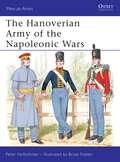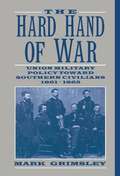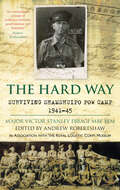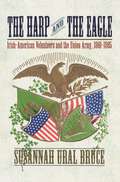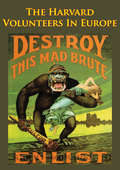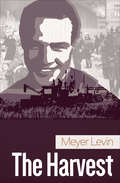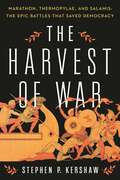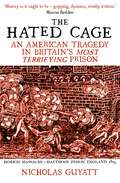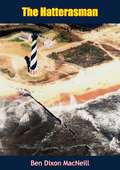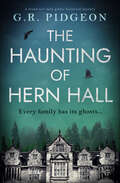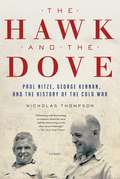- Table View
- List View
The Hanoverian Army of the Napoleonic Wars
by Peter Hofschroer Bryan FostenOf all the armies of the German States, that of Hanover remains of greatest interest to the British reader due to the close links between the crowns of the two states. Throughout the Napoleonic era Britain and Hanover had the same head of state, George III. Symbolic of their close relationship, the Hanoverian Army wore uniforms and used equipment largely similar to those used by the British Army. Complemented by numerous illustrations and photographs, plus eight full page colour plates, this text explores the uniforms and organization of the army of the Electorate of Hanover and the King's German Legion.
The Hard Hand of War: Union Military Policy Toward Southern Civilians, 1861-1865
by Mark GrimsleyThe book explores the Union army's policy of destructive attacks upon Southern property and civilian morale--how it evolved, what it was like in practice. Through comparisons with earlier European wars and through the testimony of Union soldiers and Southern civilians alike, Grimsley shows that Union soldiers exercised restraint even as they made war against the Confederate civilian population.
The Hard Road Will Take You Home: What the Special Forces Teaches Us About Innovation, Endeavour and Next-Level
by Anthony ‘Staz’ Stazicker'Incredible ... Staz is an inspiration' Nims Purja'A must read for anyone who wants to succeed and thrive under pressure' Dylan Hartley'Stacked with insights ... The book you need when the going gets tough' Aldo KaneElite Discipline meets Creative EffortAnthony 'Staz' Stazicker served an impressive 13 years of distinguished and decorated military service, ten within the Special Forces, before founding the multi-million pound technical clothing company ThruDark. Throughout his career in the Special Forces - featuring gunfights, door-kicking operations, and against-the-odds escapes - he learned hard lessons that would later provide crucial intelligence equally applicable to business, innovation and enterprise. The Hard Road Will Take You Home provides a mission plan that distils the processes and tactics Staz gathered throughout his career and translates them into tools that can be used in any number of settings, and by individuals with a wide range of experience and backgrounds. It instils the psychological cues required to bring next level success to any mission. And it lays bare the levels of discipline required to maintain that next level success. Introducing four concepts that make up the life of an elite operator - battle prep; techniques, tactics and procedures; teamwork and the lessons we should all consider when learning how to innovate, persevere and succeed - this book comes stacked with insight, easily applicable techniques and psychological processes gathered from Staz's time serving with the most resilient fighting force in the world.As a creative resource, it's a weapon.
The Hard Slog
by Karl JamesThis edition features the exact same content as the traditional text in a convenient, three-hole-punched, loose-leaf version. Books a la Carte also offer a great value-this format costs significantly less than a new textbook. Bob Blitzer has inspired thousands of students with his engaging approach to mathematics, making this beloved series the #1 in the market. Blitzer draws on his unique background in mathematics and behavioral science to present the full scope of mathematics with vivid applications in real-life situations. Students stay engaged because Blitzer often uses pop-culture and up-to-date references to connect math to students' lives, showing that their world is profoundly mathematical.
The Hard Way Home
by William C. BralyThe Hard Way Home is a detailed accounting by U.S. Army Colonel William C. Braly of his capture and 3-1/2 year internment by the Japanese during of World War II. Beginning with the surrender of Allied forces in the Philippines on May 4, 1942, The Hard Way Home chronicles Braly’s imprisonment first in Manila, then northward to camps in Luzon, Taiwan, Japan, and Manchuria. The Hard Way Home was prepared from 34 journals kept by Braly during his time as a prisoner, and are held today in the U.S. Army Military History Institute, Carlisle Barracks, Carlisle, Pennsylvania. Includes 10 pages of illustrations.
The Hard Way: Adapt, Survive and Win
by Mark BillinghamBilly Billingham grew up tough; a grim future ahead of him offering little respite from the hostile streets he walked. Leaving school at eleven years of age, the threat of borstal hanging over his head, running with gangs in Birmingham, and almost being killed in a knife fight eventually led to Billy discovering the British armed forces at sixteen years of age. It would be the making of him. Billingham would graduate from the Royal Marine cadets to enlisting with the Parachute Regiment in 1983, where he would serve with distinction as a Patrol Commander and expert sniper. In 1991 he took on an even bigger challenge – taking the SAS course – the fearsome and secretive elite special forces unit with a well-won reputation for excellence in operating in extreme and hazardous conditions. He excelled in this life, rising to the rank of sergeant major for the regiment, and undertaking dozens of classified and extremely dangerous missions. He would ultimately serve seventeen years with the SAS, serving in countless war zones, winning a commendation for bravery and being awarded the MBE. After leaving the army he would embrace the life of a bodyguard to Hollywood stars such as Angelina Jolie, Brad Pitt, Sir Michael Caine, Tom Cruise and Russell Crowe, before being recruited as one of the lead instructors on SAS - Who Dares Wins for television. Billy is a highly-decorated veteran; with a reputation for excellence, honesty and integrity not only supporting his comrades Ant Middleton, Jason Fox and Ollie Ollerton, but equally intimidating and inspiring the contestants who take on the gruelling challenges each week. The Hard Way details Billy&’s story thus far, but will also educate and enthral those wishing to seek a challenge and conquer it – the SAS way.
The Hard Way: Surviving Shamshuipo POW Camp 1941-45
by Andrew Robertshaw Victor Stanley EbbageMajor Vic Ebbage was a Colonel with the Royal Army Ordnance Corps, serving in Hong Kong in 1941, when his garrison was attacked by the Japanese Army. He was captured and taken prisoner to the notorious Hong Kong death camp, Samshuipo, where he was held from 30th December 1941 to August 1945. His story is an extraordinary one of survival against all the odds, but more than that it is a story of how a group of men worked together to improve conditions in the camp for their fellow prisoners. They were offered nothing by their captors, but their constant command of 'improvise', which they learned to do by recycling salvaged materials into everything from homemade nails, cooking pots and plates to surgical instruments, beds and nesting boxes. His diary demonstrates how individuals can work together in almost unimaginable adversity to improve life for their fellow man, and how imagination and innovation can flourish in even the worst conditions. This story is a model of care, humanity and inventiveness.
The Hardest Place: The American Military Adrift in Afghanistan's Pech Valley
by Wesley Morgan&“The definitive account of America&’s heroic but ultimately doomed effort in one of Afghanistan&’s most rugged regions.&”—Sebastian Junger, author of Tribe &“A saga of courage and futility, of valor and error and heartbreak.&”—Rick Atkinson, author of the Liberation TrilogyWhen we think of the war in Afghanistan, chances are we're thinking of a small, remote corner of the country where American military action has been concentrated: the Pech and its tributary valleys in Kunar and Nuristan provinces. The rugged, steep terrain and thick forests made the region a natural hiding spot for targets in the American war on terror, from Osama bin Laden to the Islamic State, and it has been the site of constant U.S. military activity for nearly two decades. Even as the U.S. presence in Afghanistan transitions to a drone war, the Pech has remained at the center of it, a testbed for a new method of remote warfare.Wesley Morgan first visited the Pech in 2010, while he was still a college student embedding with military units as a freelancer. By then, the Pech and its infamous tributary the Korengal had become emblematic of the war, but Morgan found that few of the troops fighting there could explain why their remote outposts had been built. In The Hardest Place, he unravels the history those troops didn&’t know, captures the culture and reality of the war through both American and Afghan eyes, and reports on the snowballing American missteps that made each unit&’s job harder than the last as storied outfits like Marines, paratroopers, Rangers, Green Berets, and SEALs all took their turn.Through reporting trips, hundreds of interviews with Americans and Afghans, and documentary research, Morgan writes vividly of large-scale missions gone awry, years-long hunts for single individuals, and the soldiers, Marines, commandos, and intelligence operatives who cycle through, along with several who return again and again to the same slowly evolving fight.As the war drags on through its fourth presidential administration, Morgan concludes that we've created a status quo that could last forever in the Pech, with the military and intelligence agencies always in search of the next target.
The Harlem Hellfighters
by Max BrooksFrom bestselling author Max Brooks, the riveting story of the highly decorated, barrier-breaking, historic black regiment—the Harlem HellfightersIn 1919, the 369th infantry regiment marched home triumphantly from World War I. They had spent more time in combat than any other American unit, never losing a foot of ground to the enemy, or a man to capture, and winning countless decorations. Though they returned as heroes, this African American unit faced tremendous discrimination, even from their own government. The Harlem Hellfighters, as the Germans called them, fought courageously on—and off—the battlefield to make Europe, and America, safe for democracy. In THE HARLEM HELLFIGHTERS, bestselling author Max Brooks and acclaimed illustrator Caanan White bring this history to life. From the enlistment lines in Harlem to the training camp at Spartanburg, South Carolina, to the trenches in France, they tell the heroic story of the 369th in an action-packed and powerful tale of honor and heart.
The Harlem Hellfighters: When Pride Met Courage
by Walter Dean Myers Bill MilesThe story of the Harlem Hellfighters is not simply one of victory in a war. . . . It is the story of men who acted as men, and who gave a good account of themselves when so many people thought, even hoped, that they would fail. What defines a true hero? The "Harlem Hellfighters," the African American soldiers of the 369th Infantry Regiment of World War I, redefined heroism -- for America, and for the world. At a time of widespread bigotry and racism, these soldiers put their lives on the line in the name of democracy. The Harlem Hellfighters: When Pride Met Courage is a portrait of bravery and honor. With compelling narrative and never-before-published photographs, Michael L. Printz Award winner Walter Dean Myers and renowned filmmaker Bill Miles deftly portray the true story of these unsung American heroes.
The Harmonica
by Tony Johnston Ron MazellanWhen the Nazis invaded Poland, a family is split apart. The parents are sent to one concentration camp, their son to another. Only his father's gift, a harmonica, keeps the boy's hopes alive and, miraculously, ensures his survival. Tony Johnston's powerf
The Harp and the Eagle: Irish-American Volunteers and the Union Army, 1861-1865
by Susannah J UralOn the eve of the Civil War, the Irish were one of America's largest ethnic groups, and approximately 150,000 fought for the Union. Analyzing letters and diaries written by soldiers and civilians; military, church, and diplomatic records; and community newspapers, Susannah Ural Bruce significantly expands the story of Irish-American Catholics in the Civil War, and reveals a complex picture of those who fought for the Union.While the population was diverse, many Irish Americans had dual loyalties to the U.S. and Ireland, which influenced their decisions to volunteer, fight, or end their military service. When the Union cause supported their interests in Ireland and America, large numbers of Irish Americans enlisted. However, as the war progressed, the Emancipation Proclamation, federal draft, and sharp rise in casualties caused Irish Americans to question—and sometimes abandon—the war effort because they viewed such changes as detrimental to their families and futures in America and Ireland.By recognizing these competing and often fluid loyalties, The Harp and the Eagle sheds new light on the relationship between Irish-American volunteers and the Union Army, and how the Irish made sense of both the Civil War and their loyalty to the United States.
The Harry Pfanz Gettysburg Trilogy, Omnibus E-book
by Harry W. PfanzAvailable for the first time as an Omnibus Ebook edition, this three-volume set is the acclaimed full account of the three days at Gettysburg, by the noted historian Harry Pfanz.First Day:For good reason, the second and third days of the Battle of Gettysburg have received the lion's share of attention from historians. With this book, however, the critical first day's fighting finally receives its due. After sketching the background of the Gettysburg campaign and recounting the events immediately preceding the battle, Harry Pfanz offers a detailed tactical description of events of the first day. He describes the engagements in McPherson Woods, at the Railroad Cuts, on Oak Ridge, on Seminary Ridge, and at Blocher's Knoll, as well as the retreat of Union forces through Gettysburg and the Federal rally on Cemetery Hill. Throughout, he draws on deep research in published and archival sources to challenge many long-held assumptions about the battle.Second Day:Gettysburg--The Second Day is certain to become a Civil War classic. What makes the work so authoritative is Pfanz' mastery of the Gettysburg literature and his unparalleled knowledge of the ground on which the fighting occurred. His sources include the Official Records, regimental histories and personal reminiscences from soldiers North and South, personal papers and diaries, newspaper files, and last -- but assuredly not least -- the Gettysburg battlefield. Pfanz's career in the National Park Service included a ten-year assignment as a park historian at Gettysburg. Without doubt, he knows the terrain of the battle as well as he knows the battle itself.Culp's Hill:Harry Pfanz provides the first definitive account of the fighting between the Army of the Potomac and Robert E. Lee's Army of Northern Virginia at Cemetery Hill and Culp's Hill--two of the most critical engagements fought at Gettysburg on 2 and 3 July 1863. Pfanz provides detailed tactical accounts of each stage of the contest and explores the interactions between--and decisions made by--generals on both sides. In particular, he illuminates Confederate lieutenant general Richard S. Ewell's controversial decision not to attack Cemetery Hill after the initial southern victory on 1 July. Pfanz also explores other salient features of the fighting, including the Confederate occupation of the town of Gettysburg, the skirmishing in the south end of town and in front of the hills, the use of breastworks on Culp's Hill, and the small but decisive fight between Union cavalry and the Stonewall Brigade.
The Harvard Volunteers In Europe Personal Records Of Experience In Military, Ambulance, And Hospital Service
by Anon M. A. DeWolfe HoweAT the outbreak of the European war, during the season of summer travel in 1914, many Harvard men were in Europe. Not a few of them were attached to the United States embassies and legations in the various capitals. The business of these offices immediately became pressing in the extreme. The labors of those officially connected with them were shared at once by volunteers-the first of the Harvard fellowship to offer a helping hand where it was needed in the sudden disorganization of an orderly world. The call to the colors of the various warring nations quickly drew into the conflict those who owed allegiance to one or another flag. In military service, such as that of the Foreign Legion and Flying Corps of the French Army, others have expressed the allegiance of sympathy if not of birth. But it has been in the organization of hospital service and in the work of ambulance corps engaged in the dangerous task of bringing wounded men with all possible speed to the ministrations of surgeons and nurses that Harvard has had by far the largest numerical representation. In hospital work it has been even an official representation, for the Surgical Units sent in the spring of 1915 to the American Ambulance Hospital in Paris, and in the summer of the same year to equip a British military hospital in France-a service undertaken originally for three months, but continued until the present time-were Units bearing the name and sanction of the University, through its Medical School. From the Medical School also Professor Strong was detached for his service of world-wide importance in combatting, successfully, the plague of typhus in Servia.
The Harvest
by Meyer LevinThe family saga that began in The Settlers continues through WWII and the creation of Israel in a novel that “follows history’s beat closely and knowingly” (Kirkus Reviews).When the Chaimovitch family fled the Russian pogroms at the turn of the twentieth century, they hoped their family could flourish in Eretz Yisroel, the land of their ancestors. Twenty years later, they are thriving in Palestine and sending their youngest son Mati off to attend an American college. But the difficulties of their old lives in Russia are harder to shake than they thought.With the rumblings of World War II comes anti-Jewish violence reminiscent of the pogroms they once fled. And that violence claims the life of Mati’s younger brother. When Mati returns home to help his family deal with the sudden tragedy, he brings his new Jewish American bride Dena. Bridging the generations, the Chaimovitch family will confront unimaginable horrors as they work toward the triumphs and trials that created the Jewish state of Israel.“The culmination of a prodigiously productive and important career.” —Norman Mailer
The Harvest of War: Marathon, Thermopylae, and Salamis: The Epic Battles that Saved Democracy
by Stephen P. KershawThe year 2022 marks 2,500 years since Athens, the birthplace of democracy, fought off the mighty Persian Empire. This is the story of the three epic battles—Marathon, Thermopylae and Salamis—that saved democracy, forever altering the history of Europe and the West.In 2022 it will be 2,500 years since the final defeat of the invasion of Greece by Xerxes, the Persian king. This astonishing clash between East and West still has resonances in modern history—and has left us with tales of heroic resistance in the face of seemingly hopeless odds. The Harvest of War makes use of recent archaeological and geological discoveries in this thrilling and timely retelling of the story, originally told by Herodotus, the Father of History. In 499 BC, when the rich, sophisticated Greek communities of Ionia on the western coast of modern Turkey rebel from their Persian overlord Darius I, Athens sends ships to help them. Darius crushes the Greeks in a huge sea battle near Miletus and then invades Greece. Standing alone against the powerful Persian army, the soldiers of Athens' newly democratic state—a system which they have invented—unexpectedly repel Darius's forces on the planes of Marathon. After their victory, the Athenians strike a rich vein of silver in their state-owned mining district, and decide to spend the windfall on building a fleet of state-of-the-art warships. Persia wants revenge. The next Persian king, Xerxes, assembles a vast multinational force, constructs a bridge of boats across the Hellespont, digs a canal through the Mount Athos peninsula, and bears down on Greece. Trusting in their "wooden walls," the Athenians station their ships at Artemisium, where they and the weather prevent the Persians landing forces in the rear of the land forces under the Spartan King Leonidas at the nearby pass of Thermopylae. Xerxes's assault is a disastrous failure, until a traitor shows him a mountain track that leads behind the Greeks. Leonidas dismisses the Greek troops, but remains in the pass with his 300 Spartan warriors where they are overwhelmed in an heroic last stand. Athens is sacked by the Persians. Democracy is hanging by a thread. But the Athenians convince the Greek allies to fight on in the narrow waters by the island of Salamis. Despite the heroism of the Persian female commander Artemisia, the Persian fleet is destroyed. The Harvest of War concludes by exploring the ideas that the decisive battles of Marathon, Thermopylae, and Salamis mark the beginnings of Western civilization itself—and that Greece became the bulwark of the West—representing the values of peace, freedom, and democracy in a region historically ravaged by instability and war.
The Harwich Striking Force: The Royal Navy's Front Line in the North Sea 1914–1918
by Steve DunnThe Harwich Force has made its name and will not be forgotten during the future annals of history’; so said Rear Admiral Sir Reginald Tyrwhitt on Armistice Day 1918. But that fame has not endured. Yet for the whole duration of the First World War, the Harwich Striking Force was the front line of the Royal Navy, a force of cruisers and destroyers defending the seas for the Allies. Under a charismatic and aggressive leader, Reginald Yorke Tyrwhitt, U-boats, German cruisers, destroyers and light craft all met their ends at the hands of the Force, as did enemy seaplanes and Zeppelin airships. The Harwich ships were at sea almost daily throughout the war, haunting the German coast and the Friesian Islands, pioneering aerial attack from the sea, developing naval carrier aviation and combined air/sea operations, and hunting for enemy submarines and minelayers in the North Sea. The Harwich Force also took part in major naval battles alongside the Grand Fleet’s battlecruisers, and protected merchant ships operating in the dangerous waters around Denmark, the Netherlands, Germany and Britain. The author also assesses the role played by the other Royal Navy formations at Harwich: submarines, auxiliary minesweeping and patrol vessels, the Felixstowe seaplane base and the town itself. And when the war was finally won, the Force gained further fame when the German U-boat fleet was surrendered there. Lavishly illustrated, this book is an enthralling account of the men of the Harwich Force, of their grit and brave sacrifice and the key part that they played in the final Allied victory against Germany.
The Hated
by Frederik PohlAfter space, there was always one more river to cross . . . the far side of hatred and murder!
The Hated Cage: An American Tragedy in Britain's Most Terrifying Prison
by Nicholas Guyatt&‘Beguiling&’ The Times &‘This is history as it ought to be – gripping, dynamic, vividly written&’ Marcus Rediker The War of 1812 – the last time Britain and America went to war with each other. British redcoats torch the White House and six thousand American sailors languish in the world&’s largest prisoner-of-war camp, Dartmoor. A myriad of races and backgrounds, with some prisoners as young as thirteen. Known as the &‘hated cage&’, Dartmoor wasn&’t a place you&’d expect to be full of life and invention. Yet prisoners taught each other foreign languages and science, put on plays and staged boxing matches. In daring efforts to escape they lived every prison-break cliché – how to hide the tunnel entrances, what to do with the earth… Drawing on meticulous research, The Hated Cage documents the extraordinary communities these men built within the prison – and the terrible massacre that destroyed these worlds.
The Hated Cage: An American Tragedy in Britain's Most Terrifying Prison
by Nicholas GuyattA leading historian reveals the never-before-told story of a doomed British prison and the massacre of its American prisoners of warAfter the War of 1812, more than five thousand American sailors were marooned in Dartmoor Prison on a barren English plain; the conflict was over but they had been left to rot by their government. Although they shared a common nationality, the men were divided by race: nearly a thousand were Black, and at the behest of the white prisoners, Dartmoor became the first racially segregated prison in US history.The Hated Cage documents the extraordinary but separate communities these men built within the prison—and the terrible massacre of nine Americans by prison guards that destroyed these worlds. As white people in the United States debated whether they could live alongside African Americans in freedom, could Dartmoor&’s Black and white Americans band together in captivity? Drawing on extensive new material, The Hated Cage is a gripping account of this forgotten history.
The Hatterasman (Lives In Place Ser.)
by Ben Dixon MacneillA classic memoir of North Carolina’s Outer Banks penned by native Ben Dixon MacNeill and winner of the 1958 Mayflower Award, The Hatterasman is part nature story, part historical narrative, part adventure story, and part rhetorical farce.
The Haunted Stars
by Edmond HamiltonIt meant little to Robert Fairlie, a serious and dedicated young philologist, that the United States and Soviet Russia were at odds about the Moon. He had little interest in the first rocket landings or the bases that the two nations had established there. And he neither knew nor cared why the Americans would not agree to mutual inspections of these bases.Yet the Americans had reason enough: and quite unexpectedly, because of his specialised knowledge of languages, he found himself sharing the burden of an incredible secret. For what the American base had yielded was astounding evidence that space had already been conquered many centuries before by a people who had once spanned the stars. There had been machines and destructive weapons beyond the comprehension of present-day scientists which, if knowledge of them fell into the wrong hands, could plunge the world into unutterable chaos.Fairlie's trip to the closely-guarded rocket base in New Mexico turned out to be only the first step on a fantastic journey amid the unexplored stars to the home-world of the space-conquerors of long ago.It was a journey into the appalling reality of stellar space still haunted by the past cosmic struggle whose scale in space and time dwarfed the rivalries of tiny Earth's quarreling nations.
The Haunting of Hern Hall
by G.R. PidgeonLong ago, three innocent children played a game—and the consequences still haunt their family, in this eerie tale set in post–World War I England . . . After the horror of the First World War, disillusioned army chaplain John Elliot arrives at Hern Hall, an isolated estate in the English countryside. Despite suffering from shellshock, John has made a promise to his friend Will, who died in the trenches while saving John&’s life. A promise he&’s determined to keep. John meets Will&’s sister Lucy, a beautiful, blind, and mysterious young woman, and is introduced to Will&’s grieving parents, Lord and Lady Chiddingstone. But the house, shrouded by mist, seems to be tormented by some tragic past . . . After being invited to stay at Hern Hall, he has a series of unsettling and eerie encounters—even attending a séance conducted by the infamous Madame Blanche, a spiritualist medium who Lady Chiddingstone hopes can communicate with her dead sons. As John grows closer to the family, he uncovers more about their traumatic history, and the disturbing secrets hiding in the walls and tunnels of their great house. Is the family cursed as an ancient legend tells? And if so, can the ghosts and the living ever find peace—or are they destined to be forever haunted by death?
The Hawk and the Dove: Paul Nitze, George Kennan, and the History of the Cold War
by Nicholas ThompsonOnly two Americans held positions of great influence throughout the Cold War. The two men embodied opposing strategies for winning the conflict. Yet they dined together, attended the weddings of each other's children, and remained lifelong friends. Paul Nitze was a consummate insider who believed the best way to avoid a nuclear clash was to prepare to win one. George Kennan was a diplomat turned academic whose famous "X article" persuasively argued that we should contain the Soviet Union while waiting for it to collapse from within. A masterly double biography,The Hawk and the Dove"does an inspired job of telling the story of the Cold War through the careers of two of its most interesting and important figures" (The Washington Monthly).
